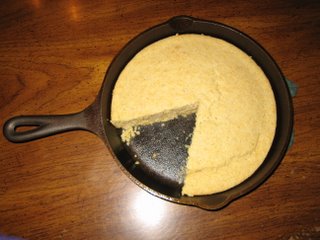 Cornbread has been a staple on American tables for generations. From pones baked up in cast iron skillets in the Appalachians to loaves laced with spicy peppers in the Southeast, cornbread has been the staff of life for many families. But today, key ingredients vital to making such simple fare as cornbread are tainted by genetically modified organisms (GMOs).
Cornbread has been a staple on American tables for generations. From pones baked up in cast iron skillets in the Appalachians to loaves laced with spicy peppers in the Southeast, cornbread has been the staff of life for many families. But today, key ingredients vital to making such simple fare as cornbread are tainted by genetically modified organisms (GMOs).Multinational companies are tinkering with the genes in important foods like corn, canola, sugar and soy to create all-new organisms. While these companies and some scientists say the foods are safe, the skeptical voice is strong. Leaders in the health, scientific and farming communities are raising serious questions and getting very unsatisfactory answers. Will pollen from these altered plants kill butterflies and other beneficial insects? Will these foods cause allergic reactions in sensitive individuals? Is it morally, ethically or religiously right to modify foods in this way?
For now, the U.S. Food and Drug Administration does not require genetically modified foods to be labeled. When you purchase food for your family, you have no assurance that your choices are safe unless the food is organic. If you are concerned, support organic farms with your purchases, write letters to your elected officials and educate yourself on this issue.
Greenpeace’s True Food Campaign Web site is a good place to start; click on www.truefoodnow.org. Small changes in your kitchen can make big changes for your family and the world. Start with the simple things – like cornbread.
1 ¼ cups yellow cornmeal
¾ cups unbleached flour
1 tablespoon non-aluminum baking powder
½ teaspoon sea salt
1 1/3 cups soymilk
1/3 cup expeller-pressed canola oil
1 tablespoon pure maple syrup
1. Preheat oven to 400 degrees. Lightly grease a 9-inch seasoned cast iron skillet or round baking dish. Set aside.
2. In a medium mixing bowl, whisk together cornmeal, flour, baking powder and sea salt.
Add soymilk, canola oil and maple syrup. Use a rubber spatula to stir until thoroughly combined.
3. Scrape batter into prepared skillet or baking dish.
4. Bake for 20-25 minutes or until a probe inserted into the center comes out clean.
5. Cool 2-3 minutes. Cut into wedges and serve immediately.





No comments:
Post a Comment